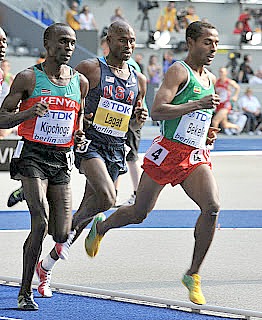Anterior posterior trunk movement means the trunk sways front to back, whereas medial lateral trunk movement means the trunk sways side to side. Based on trunk movement along the AP and ML axis could illuminate issues of poor performance and injury during running.
Trunk Movement Reflects Position of Center of Mass
Trunk movement affects average running speed whereby minimal trunk movement allows a runner to maintain higher average running speeds. Why? Minimal trunk movement indicates greater control of the center of mass, therefore trunk movement reflects center of mass position (the area between your head and hips).
- anterior posterior trunk movement means the center of mass is shifting front to back
- medial lateral trunk movement means the center of mass is shifting side to side
Lin et al. (2014) found that anterior posterior trunk movements was a predominate factor that affected performance in elite ultra runners and prevented these runners from accelerating at high speeds as compared with sub elite ultra runners who exhibited more medial lateral trunk movements.
Basically, elite distance runners utilize a more effective control strategy to prevent the center of mass from shifting too far forward or too far back. Below is a video showing how the top distance runners in the world maintain a fast pace by maintaining a secured position of a more anterior trunk posture. Furthermore, a forward trunk posture reduces knee stress in forefoot running, too.
In the same study, the elite ultra runners stabilized medial lateral trunk movements at all running speeds, with the highest stability at 10km/h as compared with the sub elite ultra runners. However, the elite runners showed greater anterior posterior trunk movements as speed increased, indicating that the center of mass is more forward to accelerate the body.

Though equally necessary is a change in step length to ensure greater control of trunk movements when forefoot running. For example, reducing stride length, reduces medial lateral trunk movements during running (Lin et al., 2014)
Overall, the elite ultra runners in the study seemed to directly benefit from greater anterior posterior trunk movements to accelerate as well as stable side-to-side trunk movements. This insight would help explain what kind of trunk movements improve forefoot running efficiency –if you want to run faster, sway the trunk forward and if you want to maintain a faster pace, hold your trunk in its respective forward position.
The Take Home Message
Running fast efficiently involves adequate pace control that corresponds to greater trunk movement control, thereby preventing sudden acceleration and deceleration.
- As you run faster, maintaining trunk and head balance becomes challenging –uncontrolled trunk movements is an energy leak, resulting in poor efficiency during running (Lin et al., 2014)
Optimizing energetics at a faster running speed requires direct attention to trunk movements. Nonetheless, this conception would help coaches considerably narrow down the list of performance enhancing contenders.
More From Run Forefoot:
- Why Forefoot Running is Better
- Forefoot Running Mistakes
- What About Barefoot Running?
- Ultra Minimalist Shoe Review
You Might Also Like:
- Be Summer Strong
- Easy to Send, Fun to Spend at Brookstone
- The House: 35 Years of Greatness
- Fat Loss Funnel
References:
Lin et al. Impact of center of mass acceleration on the performance of ultramarathon runners.J Hum Kin, 2014(44):41-52.
Bretta Riches
BSc Neurobiology; MSc Biomechanics candidate, ultra minimalist runner & founder of RunForefoot. I was a heel striker, always injured. I was inspired by the great Tirunesh Dibaba to try forefoot running. Now, I'm injury free. This is why I launched Run Forefoot, to advocate the health & performance benefits of forefoot running and to raise awareness on the dangers of heel striking, because the world needs to know.
Latest posts by Bretta Riches (see all)
- Cushioned Running Shoes Found to Be Bad for Ankles - 23/04/2024
- Forefoot Running and Achilles Pain - 19/04/2024
- Does Foot Strike Really Matter in Running? YES! - 17/04/2024

Leave a Reply